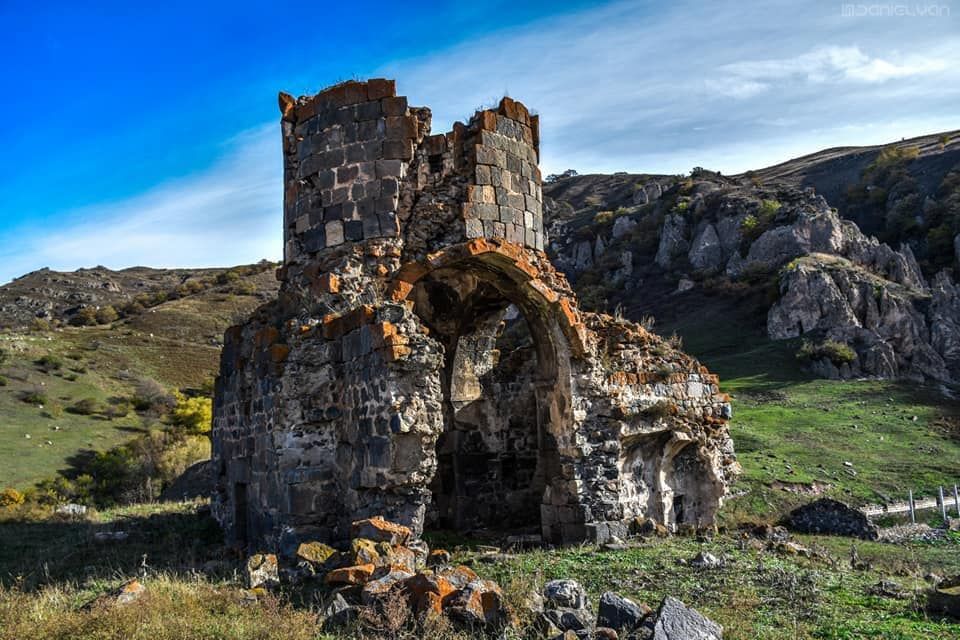On a grassy plateau amid the mountains of Kashatagh stands the church of Varazgom. The height of the church contrasts sharply with the rolling hills nearby, yet its rocky appearance ties it to the natural landscape. The church, now in ruins, invites you to wander through its crumbling arches and ponder: what did it look like in its prime? and what has it endured in the centuries since? The precise date of its construction is unknown, but its overall shape and technique suggest it was built in the 10th or 11th century. The overall effect of Varazgom is serenely picturesque, cloaked in the mystery of a bygone era.
Reading the Ruins
At first, the ruins of Varazgom may seem elusive, but even the fragmented structure tells a compelling story. The drum of the church still reaches the impressive height of 9 meters, far above human scale. When the dome and pointed umbrella roof were intact, the church would have risen even higher, echoing the snow-covered peaks in the distance and drawing visitors’ eyes up toward Heaven. From the arches under the dome, you can imagine the interior vaults, now covered in plaster but perhaps once vibrantly painted with frescoes. Envisioning the former glory of Varazgom may take some imagination, but the ruins easily inspire you to recreate the church in your mind.
The ruins of the church also speak to the architectural individuality of Varazgom. The church has an eastern apse, the location in a church where the altar is located and the liturgy is performed. However, in addition to this standard apse, Varazgom has an unexpected second apse in the northern arm of the church. The distinctiveness of this feature cannot be overstated—there are no other two-apsed churches like Varazgom documented in all the Caucasus! This second apse could have been used for an additional altar, or perhaps as a burial space for a patron of the church.
The vault of the dome is equally unique to Varazgom. Traditionally, the transition from the square center of a church to the round base of the dome is bridged in two ways: with squinches, which are shaped somewhat like concave seashells, or with pendentives, which are more like curved triangles. Varazgom breaks with this tradition by using both, two squinches and two pendentives. The reasoning for this choice, as well as the impact on architectural stability of the church, remains unclear. Yet, the unexpected additions, both in the vault of the dome and the second apse, further spark the imagination to consider what a special building Varazgom was and continues to be.
Creative Carvings
While exploring the mysteries of Varazgom, a variety of intricately carved sculptures capture your attention. Inside the tall drum of the dome, there are four sculptures in high relief: a lion, an eagle, an ox, and a winged man. These are the symbols of the four evangelists, who wrote the gospels in the Bible. Depictions of the evangelist symbols under the dome is a common feature of Armenian and Byzantine churches; however, it is more usual for the symbols to appear as reliefs, mosaics, or frescoes in the pendentives under the drum, rather than in the drum itself. The placement of the evangelist reliefs is yet another unique variation of Varazgom!
The area around the church is scattered with fragments of Armenian khachkars, or cross-stones. At first glance, they may appear part of the natural landscape. This is partially by design—khachkars are carved from locally available tuff stone, and are thus directly connected to the landscape through their material. Though they may be difficult to spot, these intricately carved stones are worth looking for in a walk around the church. All khachkars contain a large central cross, but they vary greatly in their sculptural details. Some are more geometric, while others feature elaborate vegetal designs. Some are so finely carved they resemble the delicate needlework of lace rather than stone! Khachkars also contain important historical information. These stones could function as funerary monuments, with the names and dates of the people they commemorate. Others were built as memorials to specific events or donations to a church, with inscriptions on the khachkars recording the details like a stone document.
